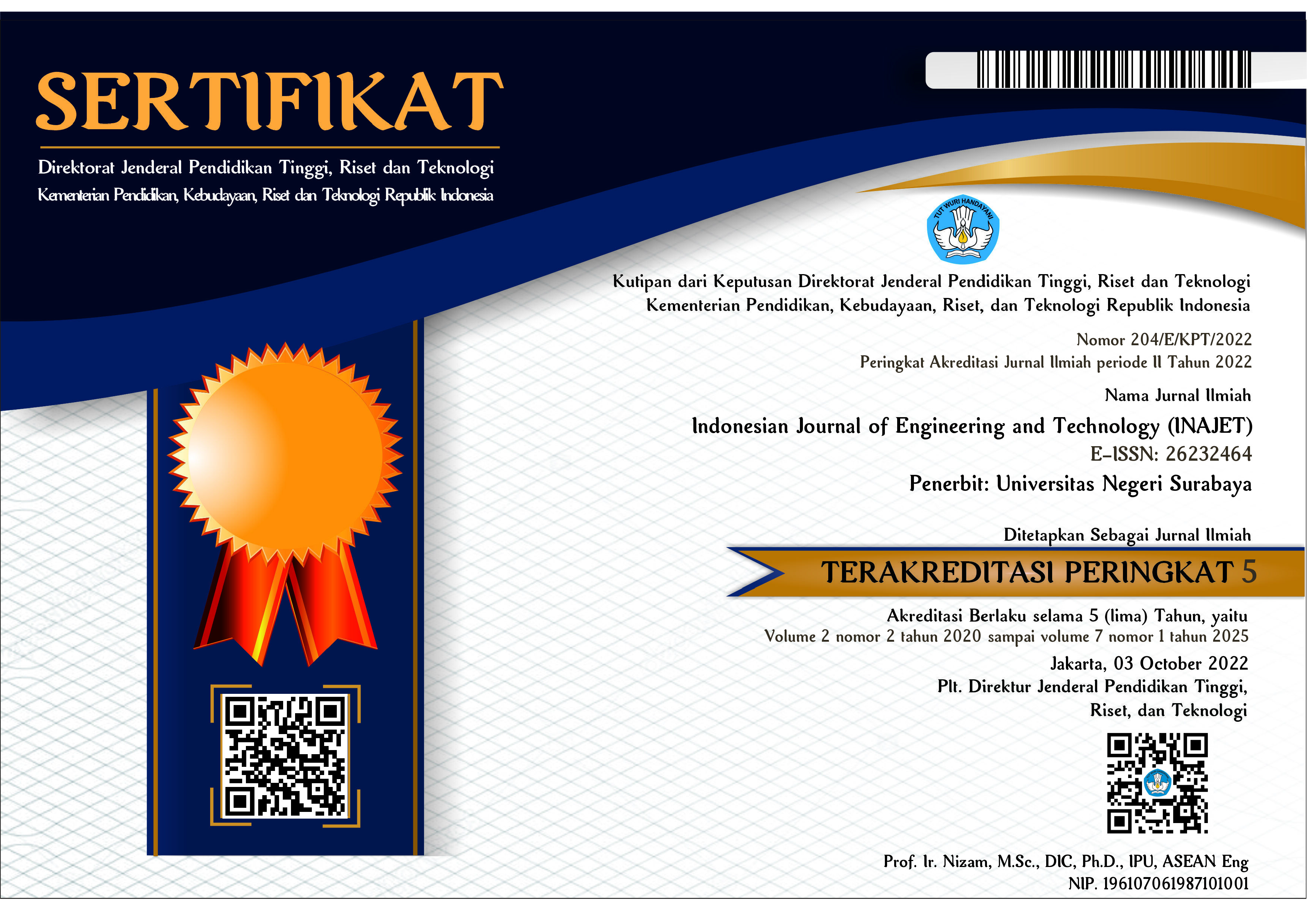Analysis of Fiber Orientation on the Bending Strength of Aluminium-Carbon Fiber FML Composites
DOI:
https://doi.org/10.26740/inajet.v8n1.p19-24Keywords:
Bending, Carbon Fiber, Composite, Fiber Metal Laminate, Vacuum InfusionAbstract
One such innovation is the application of composite materials as subtitutes for conventional metals. However, pure composites exhibit poor resistance to shock loads, leading to the development of Fiber Metal Laminates (FMLs), which combine carbon fiber and aluminium sheets. This research investigates the flexural behavior of carbon fiber-reinforced FMLs with varying fiber orientations (0°, 45°, dan 90°). The study employed a quantitative approach using an experimental method to evaluate the mechanical response under bending conditions. The laminates were manufactured using the vacuum infusion process, with epoxy resin as the matrix and aluminium as laminates and core. Bending tests were conducted in accordance with ASTM D790, using a Tarno Grocki universal testing machine. The results were evaluated based on maximum flexural strenght. The results showed significant differences in bending strenght based on fiber orientation. The highest bending strenght was recorded at 0° (111.43 MPa), followed by 45° (90.92 MPa), and 90° (69.87 MPa). This research may serve as a reference for futher development of FML composites for automotive body aplications.
References
Abd El‐baky, M. A., & Attia, M. A. (2020). Experimental study on the improvement of mechanical properties of GLARE using nanofillers. Polymer Composites, 41(10), 4130-4143.
Ahmad, H., et al. 2020. A review of carbon fiber materials in automotive industry. IOP Conf. Ser.: Mater. Sci. Eng., 971(3), 032011
Annual Book of Standards, Section 8, D 790-03, “Standard Test Methods for Flexural Properties of Unreinforced and Reinforced Plastics and Electrical Insulating Materials1”, ASTM, 2002.
Bieniaś, J., & Dadej, K. (2020). Fatigue delamination growth of carbon and glass reinforced fiber metal laminates in fracture mode II. International Journal of Fatigue, 130, 105267.
Bunsell, A. R., Joannès, S., & Thionnet, A. (2021). Fundamentals of fibre reinforced composite materials. CRC Press.
Callister, W. D., & Rethwisch, D. G. 2022. Fundamentals of Materials Science and Engineering. Wiley.
Chen, Y., Wang, Y., & Wang, H. (2020). Research progress on interlaminar failure behavior of fiber metal laminates. Advances in Polymer Technology, 2020(1), 3097839.
Faiz, M. 2021. Compression Failure in Sandwich Laminates. Eng. Failure Anal., 127, 105479.
Fajarudin, A. 2021. Tensile Properties of Carbon Fiber Based on Fiber Angle. JETS, 53(4), 520–526.
Gay, D. 2022. Composite materials: design and applications. CRC press.
Huberty, J., et al. 2024. Comparison of VARI and RTM for FMLs. Adv. Composite Mater., 33(1), 58–67.
Khumaidillah, M. R., et al. 2023. Analysis of Carbon Fiber with Balsa Wood Core on Mechanical Strength Using Bending Test. Jurnal Rekayasa Mesin, 8(1), 30–36.
Lerdwongpaisan, A. 2023. Experimental and numerical study of springback of composite structures: considering mould/laminated part interaction (Doctoral dissertation, INSA de Toulouse).
Naito, K., Shirasu, K., & Tanaka, Y. (2020). Effect of carbon fibres on the static and fatigue mechanical properties of fibre metal laminates. Fatigue & Fracture of Engineering Materials & Structures, 43(7), 1461-1472.
Patel, M., et al. 2023. Blast Analysis of CFRP/Steel FMLs. Int. J. Impact Eng., 178, 104609.
Utomo, S. W. E., & Irfai, M. A. 2020. Effect of Volume Fraction and Orientation on Impact Strength. Jurnal Teknik Mesin, 8(2), 73–80.
Zhu, Y. 2020. Matrix Cracking in Composite Laminates. Composite Structures, 238, 111973.
Downloads
Published
How to Cite
Issue
Section
 Abstract views: 92
,
Abstract views: 92
, PDF Downloads: 113
PDF Downloads: 113











